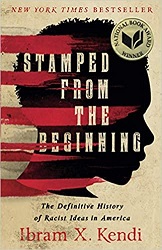
 Stamped from the Beginning
Stamped from the BeginningThe Definitive History of Racist Ideas in America
Review posted April 26, 2021.
Bold Type Books, 2016. 583 pages.
Review written April 25, 2021, from my own copy
Starred Review
2021 Sonderbooks Standout:
#1 Nonfiction
I got to hear Dr. Ibram Kendi and children’s author Jason Reynolds speak about this book at ALA Annual (Virtual) Conference in June 2020. Jason Reynolds used the research from this book to write a version for young people. Soon after the conference, I listened to the audiobook where Jason Reynolds reads his version, and I was amazed. I ordered myself a copy of the original book – and it took me much longer to read it and absorb the information.
It’s not that it’s not amazingly good and thorough and eye-opening. But it’s densely written and packed with information. I only read a chapter at a time, so it took me a long time to get through it, but I’m deeply glad I did.
This book doesn’t make me comfortable. I didn’t know much about systemic racism at all. I didn’t recognize the racist ideas that I always accepted as normal, from the time I was a kid. But wow – it is a good thing to learn about.
This is a book about racist ideas, not a book about racist people. It’s fascinating to me that the author presents that a single person can have both racist ideas and antiracist ideas. And those may change over time. It’s not that a person is hopelessly racist, but they may put forward racist ideas and act on racist ideas.
He also distinguishes between two kinds of racist ideas – segregationists and assimilationists. I’ll quote a section in the Prologue that talks about the three kinds of ideas, and this will also give you an idea of the style of the book.
In 2016, the United States is celebrating its 240th birthday. But even before Thomas Jefferson and the other founders declared independence, Americans were engaging in a polarizing debate over racial disparities, over why they exist and persist, and over why White Americans as a group were prospering more than Black Americans as a group. Historically, there have been three sides to this heated argument. A group we can call segregationists has blamed Black people themselves for the racial disparities. A group we can call antiracists has pointed to racial discrimination. A group we can call assimilationists has tried to argue for both, saying that Black people and racial discrimination were to blame for racial disparities. During the ongoing debate over police killings, these three sides to the argument have been on full display. Segregationists have been blaming the recklessly criminal behavior of the Black people who were killed by police officers. Michael Brown was a monstrous, threatening thief, therefore Darren Wilson had reason to fear him and to kill him. Antiracists have been blaming the recklessly racist behavior of the police. The life of this dark-skinned eighteen-year-old did not matter to Darren Wilson. Assimilationists have tried to have it both ways. Both Wilson and Brown acted like irresponsible criminals.
Listening to this three-way argument in recent years has been like listening to the three distinct arguments you will hear throughout Stamped from the Beginning. For nearly six centuries, antiracist ideas have been pitted against two kinds of racist ideas: segregationist and assimilationist. The history of racial ideas that follows is the history of these three distinct voices – segregationists, assimilationists, and antiracists – and how they each have rationalized racial disparities, arguing why Whites have remained on the living and winning end, while Blacks remained on the losing and dying end.
The title of the book is taken from a speech by Jefferson Davis and points out his racist, segregationist thinking. But it’s tougher to recognize that assimilationist thinking is also racist. Here’s more from the Prologue:
It may not be surprising that Jefferson Davis regarded Black people as biologically distinct and inferior to White people – and Black skin as an ugly stamp on the beautiful White canvas of normal human skin – and this Black stamp as a signifier of the Negro’s everlasting inferiority. This kind of segregationist thinking is perhaps easier to identify – and easier to condemn – as obviously racist. And yet so many prominent Americans, many of whom we celebrate for their progressive ideas and activism, many of whom had very good intentions, subscribed to assimilationist thinking that also served up racist beliefs about Black inferiority. We have remembered assimilationists’ glorious struggle against racial discrimination, and tucked away their inglorious partial blaming of inferior Black behavior for racial disparities. In embracing biological racial equality, assimilationists point to environment – hot climates, discrimination, culture, and poverty – as the creators of inferior Black behaviors. For solutions, they maintain that the ugly Black stamp can be erased – that inferior Black behaviors can be developed, given the proper environment. As such, assimilationists constantly encourage Black adoption of White cultural traits and/or physical ideals.
He admits this is a complicated book:
There was nothing simple or straightforward or predictable about racist ideas, and thus their history. Frankly speaking, for generations of Americans, racist ideas have been their common sense. The simple logic of racist ideas has manipulated millions over the years, muffling the more complex antiracist reality again and again. And so, this history could not be made for readers in an easy-to-predict narrative of absurd racists clashing with reasonable antiracists. This history could not be made for readers in an easy-to-predict, two-sided Hollywood battle of obvious good versus obvious evil, with good triumphing in the end. From the beginning, it has been a three-sided battle, a battle of antiracist ideas being pitted against two kinds of racist ideas at the same time, with evil and good failing and triumphing in the end. Both segregationist and assimilationist ideas have been wrapped up in attractive arguments to seem good, and both have made sure to re-wrap antiracist ideas as evil. And in wrapping their ideas in goodness, segregationists and assimilationists have rarely confessed to their racist public policies and ideas. But why would they? Racists confessing to their crimes is not in their self-interest. It has been smarter and more exonerating to identify what they did and said as not racist. Criminals hardly ever acknowledge their crimes against humanity. And the shrewdest and most powerful anti-Black criminals have legalized their criminal activities, have managed to define their crimes of slave trading and enslaving and discriminating and killing outside of the criminal code. Likewise, the shrewdest and most powerful racist ideologues have managed to define their ideas outside of racism. Actually, assimilationists first used and defined and popularized the term “racism” during the 1940s. All the while, they refused to define their own assimilationist ideas of Black cultural and behavioral inferiority as racist. And segregationists, too, have always resisted the label of “racist.” They have claimed instead that they were merely articulating God’s word, nature’s design, science’s plan, or plain old common sense.
Racist ideas began in fifteenth-century Europe – and were developed and promoted in order to justify slavery. In this book, Dr. Kendi traces those ideas from their origin all the way through Obama’s presidency. There’s a little bit in the Preface to the Paperback Edition about the election of Trump, but not much because it had recently happened. He does sum up what comes across in the book, that the history of racist ideas is not a simple progression:
Stamped from the Beginning . . . does not present a story of racial progress, showing how far we have come, and the long way we have to go. It does not even present a story of racial progress of two steps forward – as embodied in Obama – and one step back – as embodied in Trump.
As I carefully studied America’s racial past, I did not see a singular historical force arriving at a postracial America. I did not see a singular historical force becoming more covert and implicit over time. I did not see a singular historical force taking steps forward and backward on race. I saw two distinct historical forces. I saw a dual and dueling history of racial progress and the simultaneous progression of racism. I saw the antiracist force of equality and the racist force of inequality marching forward, progressing in rhetoric, in tactics, in policies.
When the Obamas of the nation broke through racial barriers, the Trumps of the nation did not retire to their sunny estates in Florida. They created and sometimes succeeded in putting new and more sophisticated barriers in place, like the great-grandchildren of Jim Crow voting laws – the new age-voter ID laws that are disenfranchising Black Americans in the twenty-first century. And the Trumps of the nation developed a new round of racist ideas to justify those policies, to redirect the blame for racial disparities away from those new discriminatory policies and onto the supposed Black pathology.
That gives you an idea of how dense and packed with information this book is. It includes what scholarly and popular discussions occurred at various times in American history and is backed up with amazing research. I do highly recommend approaching it the same way I did and listening to or reading the young adult version by Jason Reynolds first. That will give you the big picture before you tackle this high-level academic tome. I’m planning, in fact, to listen to the Jason Reynolds book again, in order to solidify the ideas in a more graspable form, now that I’ve dived deep.
This is an amazing work of scholarship, and I highly recommend it for every American. You’ll gain a much better understanding of racist ideas and where they came from, and your eyes will be opened to some of them that you may have always taken for granted.
